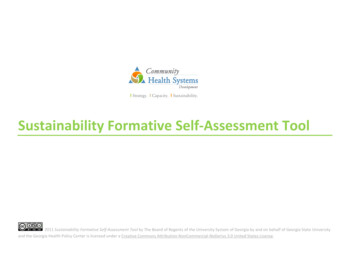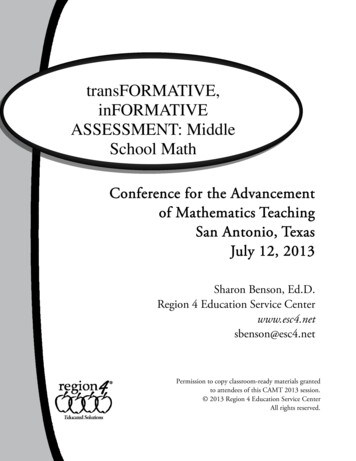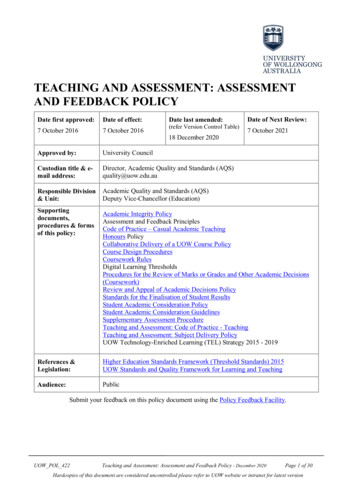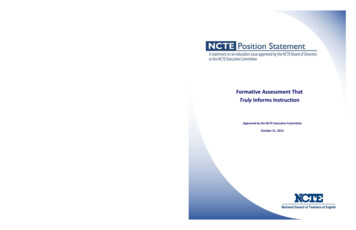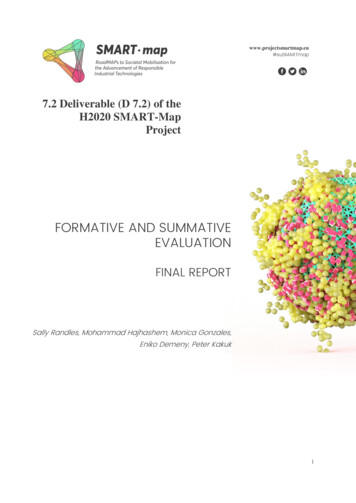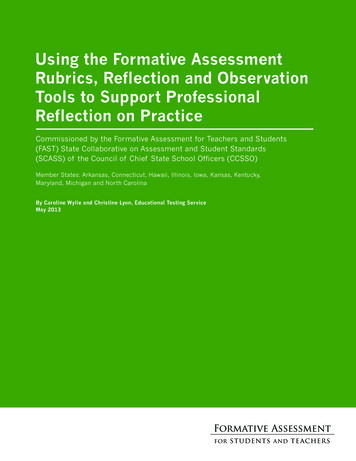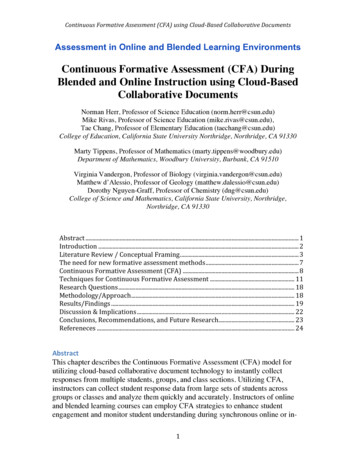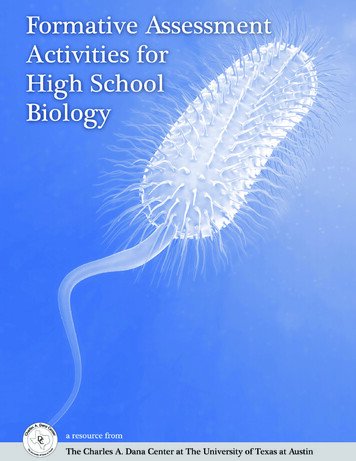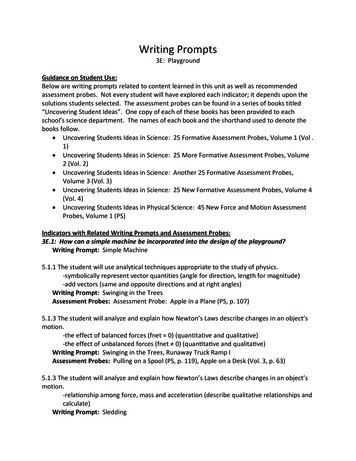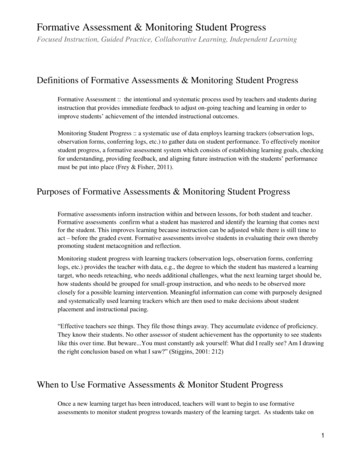
Transcription
Formative Assessment & Monitoring Student ProgressFocused Instruction, Guided Practice, Collaborative Learning, Independent LearningDefinitions of Formative Assessments & Monitoring Student ProgressFormative Assessment :: the intentional and systematic process used by teachers and students duringinstruction that provides immediate feedback to adjust on-going teaching and learning in order toimprove students’ achievement of the intended instructional outcomes.Monitoring Student Progress :: a systematic use of data employs learning trackers (observation logs,observation forms, conferring logs, etc.) to gather data on student performance. To effectively monitorstudent progress, a formative assessment system which consists of establishing learning goals, checkingfor understanding, providing feedback, and aligning future instruction with the students’ performancemust be put into place (Frey & Fisher, 2011).Purposes of Formative Assessments & Monitoring Student ProgressFormative assessments inform instruction within and between lessons, for both student and teacher.Formative assessments confirm what a student has mastered and identify the learning that comes nextfor the student. This improves learning because instruction can be adjusted while there is still time toact – before the graded event. Formative assessments involve students in evaluating their own therebypromoting student metacognition and reflection.Monitoring student progress with learning trackers (observation logs, observation forms, conferringlogs, etc.) provides the teacher with data, e.g., the degree to which the student has mastered a learningtarget, who needs reteaching, who needs additional challenges, what the next learning target should be,how students should be grouped for small-group instruction, and who needs to be observed moreclosely for a possible learning intervention. Meaningful information can come with purposely designedand systematically used learning trackers which are then used to make decisions about studentplacement and instructional pacing.“Effective teachers see things. They file those things away. They accumulate evidence of proficiency.They know their students. No other assessor of student achievement has the opportunity to see studentslike this over time. But beware.You must constantly ask yourself: What did I really see? Am I drawingthe right conclusion based on what I saw?” (Stiggins, 2001: 212)When to Use Formative Assessments & Monitor Student ProgressOnce a new learning target has been introduced, teachers will want to begin to use formativeassessments to monitor student progress towards mastery of the learning target. As students take on1
Formative Assessment & Monitoring Student ProgressFocused Instruction, Guided Practice, Collaborative Learning, Independent Learningmore responsibility of the learning, teachers will want to observe students’ understanding as well astheir language use and metacognitive strategies they use in working towards mastery of the learningtarget.How to Use Formative Assessments & Monitor Student Progress Teacher’s Role: Know what it is that students need to know and be able to do in order to have a clearlearning target Plan formative assessments that will elicit data about students’ growth towards masteryof the learning target Select an appropriate tool to track student progress, e.g., learning trackers, checklist,recording observations, etc. Share with students how this progress check will occur Determine which students you will monitor for the day Gather the data Interpret the data and make instructional decisions based on the data Provide students with feedback concerning their learning progress Reflect on success and improvement needed to teaching points Student’s Role: Be aware of and understand the daily learning target Set meaningful learning goals Participate in the learning process by engaging in the learning tasks, asking questions,and providing feedback When the teacher circulates the classroom during an observation, provide anexplanation for thinking Use teacher and peer feedback to inform learning and adjust goalsHow to Launch Formative Assessments & Monitoring Student Progress Establish the purposes of formative assessments and monitoring student progressExplain the various formative assessments and ways you will be monitoring student progress. Studentsalso need to know when these checks for understanding are to be used.Model how you will be using formative assessments and monitoring student progress each time you aregoing to be using formative assessments and monitoring student progress in a new way, so studentsunderstand the routine and what is expected of themDevelop common formative assessments with other teachers in your grade level or department. Meetafter scoring the common assessment to review student data and determine next steps in instruction.Checklist for Formative Assessments & Monitoring Student Progress2
Formative Assessment & Monitoring Student ProgressFocused Instruction, Guided Practice, Collaborative Learning, Independent Learning What is it that students need to know and be able to do in order to have a clear learning target? What formative assessments will elicit data about students’ growth towards mastery of the learningtarget? What tool will you use to track student progress, e.g., learning trackers, checklist, recordingobservations, etc.? How will you share with students how this progress check will occur? How will you determine which students you will monitor for the day? When will you gather the data? When will you interpret the data and make instructional decisions based on the data? When will you provide students with feedback concerning their learning progress?Materials for Formative Assessments & Monitoring Student ProgressMaterials for formative assessments will vary, depending upon the different type of formativeassessments used. Some examples of formative assessments are as follows: Using ORAL LANGUAGE to Check for Understandingo Accountable Talko Noticing Nonverbal Clueso Value Lineupso Retellingso Think-Pair-Shareo Misconception Analysiso Whip Aroundo Think-aloudso Voice/Response: Croakit, Vocaroo (Tech Tools) Using QUESTIONING to Check for Understandingo Constructing Effective Questionso Providing Nonverbal Supporto Developing Authentic Questionso Response Cardso Hand Signalso Audience Response Systemso Socratic Seminaro Game Based: Kahoot, FlipQuiz, Jeopardy Labs, Quizlets (Tech Tools)o Interactive Presentation: Peardeck, Nearpod (Tech Tools)o Quizzes: Google Forms (Tech Tools)o Student Response/Polling: Plickers, Polleverywhere, Socrative, Geddit (Tech Tools) Using WRITING to Check for Understandingo Interactive Writingo Read,Write, Pair, Share3
Formative Assessment & Monitoring Student ProgressFocused Instruction, Guided Practice, Collaborative Learning, Independent LearningooooooooooooooooooSquares, Triangles, CirclesRAFTExit SlipsReflection and Self-AssessmentPeer FeedbackQuick WritesMetaphor / Analogy GenerationGraphic OrganizersFoldablesAnnotations: Notable PDF, Google Drawing, Videonot.es (Tech Tools)Backchannel Chats/Discussions: Todays Meet, Twitter Hashtag Chat (Tech Tools)Compare/Contrast Writing: Wordle, Tagxedo, Tagul (Tech Tools)Discussion/Commenting: Google Classroom, Google Doc Collaboration (Tech Tools)Exit Slips: Google Form, Socrative (Tech Tools)Online Bulletin Board/Post-its: Padlet, Linoit (Tech Tools)Rubrics: Goobric (Tech Tools)Web/Concept Map/Mindmapping: Popplet, MindMeister (Tech Tools)Web Whiteboard: Awwap, Educreations (Tech Tools) Using PROJECTS and PERFORMANCES to Check for Understandingo Readers’ Theatreo Multi-media / Multi-genre Presentationso Electronic and Paper Portfolioso Dioramaso Public Performanceso Skill Demonstrationso Caption/Headline: Piclits (Tech Tools)o Compare/Contrast Writing: Wordle, Tagxedo, Tagul (Tech Tools)o Illustrations/Sketch: Google Drawing, Pixlr (Tech Tools)o Infographic: Piktochart, Ease.ly (Tech Tools)o Portfolios: Google Sites, Tackk (Tech Tools)o Rubrics: Goobric (Tech Tools)o Screencasting: Screencast-o-matic, Screencastify, Educreations (Tech Tools)o Video Capture: YouTube Capture, FlipGrid (Tech Tools)o Video Create: Animoto, Magistro (Tech Tools)o Web/Concept Map/Mindmapping: Popplet, MindMeister (Tech Tools)o Web Whiteboard: Awwap, Educreations (Tech Tools) Using NON-VERBAL COMMUNICATION to Check for Understandingo Thumbs-up / Thumbs- downo Fist-to-Fiveo Four-Cornerso On-the-Fence4
Formative Assessment & Monitoring Student ProgressFocused Instruction, Guided Practice, Collaborative Learning, Independent LearningoooPlickers / ClickersObserving body language and facial expressionsTableauA variety of observational tools have been developed by teachers and other educators to assist ingathering performance data. Depending upon the feedback that is desired, the teacher develops/uses aform that allows student performance data to be recorded. These do not need to be lengthy or complexin design. Some samples have been hyperlinked below: Status-of-the-Class – example found in folder Speaking and Listening Observation Logs – example found in folder Conferring Logs – example found in folderTech Tools for Formative Assessments & Monitoring Student Progress PlickersPoll oom Videos of Formative Assessments & Monitoring StudentProgress Elementary Classroom Video “Formative Assessments: Understanding Fractions”Secondary Classroom Videos “Formative Assessments Using the U-P-S Strategy” “Making it Click: Assessment with Technology"”Articles to Extend Learning about Formative Assessments & MonitoringStudent ProgressFisher, D., & Frey, N. (2011, September 1). “Checking for Understanding”. Retrieved May 1, 2014,from https://www.nassp.org/Content/158/PLSept11 instructldr.pdf"3 F's of Formative Assessment - Tackk." Retrieved May 26, 2015, https://tackk.com/for."Make It Count: Providing Feedback as Formative “ Edutopia." Retrieved May 26, ck-as-formative-assessment-troy-hicks5
Formative Assessment & Monitoring Student ProgressFocused Instruction, Guided Practice, Collaborative Learning, Independent Learning"Not All Formative Assessment Is Created Equal Formative ." Retrieved May 26, es/Positions/formative-assessment booklet.pdfDexter, PhD., D., & Hughes, PhD., C. (n.d.). Progress Monitoring Within a Response-To InterventionModel. Retrieved May 28, 2015, from monitoringwithin-a-rti-modelResearch for Formative Assessments & Monitoring Student ProgressFrey, Nancy & Fisher, Doug. The Formative Assessment Action Plan: Practical Steps toMore Successful Teaching and Learning. Alexandria, Virginia: ASCD, 2011.Stiggins, Richard. Student-involved Classroom Assessment. 3rd ed. Upper Saddle River, New Jersey:Merrill, Prentice Hall, 2001.Safer, N., & Fleishman, S. (2005, February 1). Research Matters / How Student Progress MonitoringImproves Instruction. Educational Leadership, 81-83.6
Focused Instruction, Guided Practice, Collaborative Learning, Independent Learning 1 Definitions of Formative Assessments & Monitoring Student Progress Formative Assessment :: the intentional and systematic process used by teachers and students during instruction that provides immediate feedback to adjust on-going teaching and learning in order to
